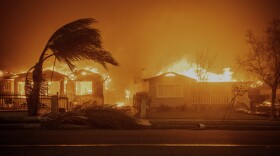Two teams of geologists say portions of the seafloor along the Aleutian Islands in southwestern Alaska could produce tsunamis more devastating than anything seen in the past century. They say California and Hawaii are directly in the line of fire.
Tsunamis — the giant waves generated by undersea earthquakes or landslides — have hit U.S. shorelines before. Often they start along the Aleutian island chain that curves in an arc across the North Pacific. Right underneath, there's a trench where two pieces of the Earth's crust are colliding. The edge of the Pacific Plate is shoving itself under the edge of the North American Plate.
Occasionally a segment of the trench along the plate margins gives way with ferocious results — a big earthquake. These subduction quakes are the type that produces a tsunami, as a giant section of the earth collapses. It's like waving your hand underwater — the collapse creates a wave that can travel thousands of miles. In the past century, several such tsunamis have inundated parts of Hawaii, Alaska and California.
Geophysicist John Miller and a team at the U.S. Geological Survey have been studying one particular segment that worries Miller. It's quiet. Too quiet.
"The stress isn't being relieved by small seismic events," Miller says, referring to small earthquakes. "It suggests that it's building up a tremendous amount of tension." If too much tension builds up, the segment will unzip along the plate margin or along faults in that margin, causing a quake. His research team's analysis was recently published online in the journal Geochemisry, Geophysics, Geosystems.
Miller says this segment of the trench, called the Semidi, poses a special risk. A tsunami created by its rupture would travel outward at a 90-degree angle from the segment. "[A] perpendicular [line] to that section of the trench," he says, "aims right at California." He says that means a big quake could produce a tsunami that would score a direct hit on California's coastline from San Francisco to Los Angeles.
In the past hundred years, other tsunamis have come from other parts of the Aleutians, he points out; since the trench is shaped in an arc, each segment of it "points" in a slightly different direction in terms of the waves created when it ruptures. Consequently, tsunamis emanating from that region of the seafloor in the recent past have mostly missed population centers, or struck only glancing blows. The Semidi, in contrast, points directly at Central California.
Miller and his team have found evidence that the Semidi segment ruptures about once every 180 to 270 years. The last time it erupted was 1788.
"That last great earthquake was 227 years ago; so there's a possibility that we're going to have another big one at any time," Miller says, because we're near the end of that recurrence interval.
Miller says a tsunami from the Semidi could be as big as the one that struck Japan in 2011. "I think the public just needs to be aware that tsunamis of this magnitude can occur, and they can cause a lot of damage," he says.
Coincidentally, another USGS team says there's another part of the Aleutian chain that poses what the scientists say is a "previously unrecognized" tsunami threat. Geologist Rob Witter, out of Anchorage, Alaska, led that team. An underground rupture and resulting quake along certain parts of that trench, he says, would point a tsunami "straight toward Hawaii."
Witter says this segment of the trench hasn't been considered a threat by most scientists because it's "creeping" — the opposing edges along the trench there are actually moving, relative to each other, but very slowly. Theoretically, that should relieve the stress, making a quake unlikely.
But not so fast, says Witter. There's now good evidence that this creeping segment has in fact caused quakes as well as tsunamis in the past. His team has found evidence of at least six such events over the past 1,700 years that probably started with ruptures in this Fox Island section.
The evidence includes sheets of sand and debris that were pushed up onto hills on another Alaskan island as the big waves moved in. One of those tsunamis was so big it pushed huge logs and other debris about 50 feet above sea level.
Witter notes that Hawaii and California have warning systems that would alert people of a tsunami's arrival at least four hours ahead of time. But residents have to pay attention to those warnings, if they're to work, he says. "I think the take-home message here is, be aware and practice your evacuation plan. A tsunami along the coastlines could happen. It could happen tomorrow."
Witter's research was published online this month in the journal Geophysical Research Letters. He says he is not surprised that the peculiarities of these segments are just now coming to light. "Hardly anything is known about the long-term history of earthquakes and tsunamis in the Aleutian chain over the last several thousand years," he says. There's an urgent need, he says, to do more surveys of the seafloor in the area to understand what's going on there, and what's likely to happen in the future.
Copyright 2016 NPR. To see more, visit http://www.npr.org/.






